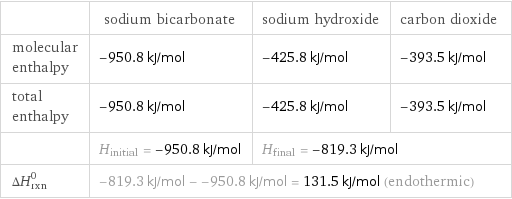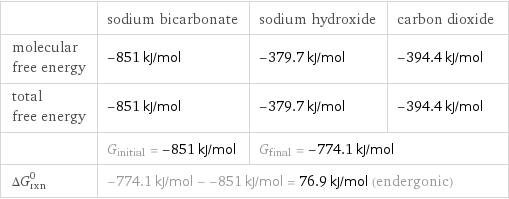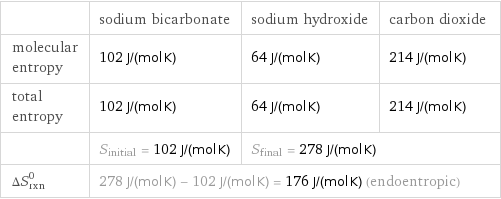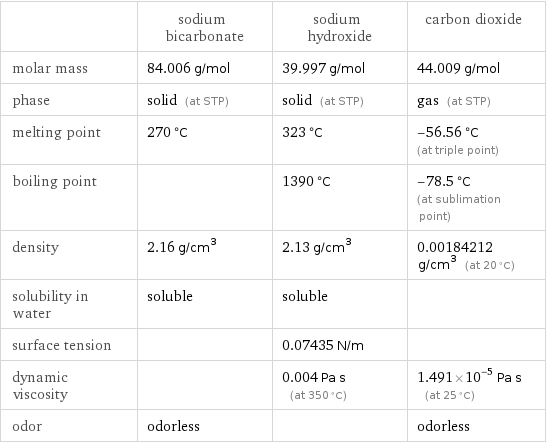Input interpretation

NaHCO_3 sodium bicarbonate ⟶ NaOH sodium hydroxide + CO_2 carbon dioxide
Balanced equation

Balance the chemical equation algebraically: NaHCO_3 ⟶ NaOH + CO_2 Add stoichiometric coefficients, c_i, to the reactants and products: c_1 NaHCO_3 ⟶ c_2 NaOH + c_3 CO_2 Set the number of atoms in the reactants equal to the number of atoms in the products for C, H, Na and O: C: | c_1 = c_3 H: | c_1 = c_2 Na: | c_1 = c_2 O: | 3 c_1 = c_2 + 2 c_3 Since the coefficients are relative quantities and underdetermined, choose a coefficient to set arbitrarily. To keep the coefficients small, the arbitrary value is ordinarily one. For instance, set c_1 = 1 and solve the system of equations for the remaining coefficients: c_1 = 1 c_2 = 1 c_3 = 1 Substitute the coefficients into the chemical reaction to obtain the balanced equation: Answer: | | NaHCO_3 ⟶ NaOH + CO_2
Structures

⟶ +
Names

sodium bicarbonate ⟶ sodium hydroxide + carbon dioxide
Reaction thermodynamics
Enthalpy

| sodium bicarbonate | sodium hydroxide | carbon dioxide molecular enthalpy | -950.8 kJ/mol | -425.8 kJ/mol | -393.5 kJ/mol total enthalpy | -950.8 kJ/mol | -425.8 kJ/mol | -393.5 kJ/mol | H_initial = -950.8 kJ/mol | H_final = -819.3 kJ/mol | ΔH_rxn^0 | -819.3 kJ/mol - -950.8 kJ/mol = 131.5 kJ/mol (endothermic) | |
Gibbs free energy

| sodium bicarbonate | sodium hydroxide | carbon dioxide molecular free energy | -851 kJ/mol | -379.7 kJ/mol | -394.4 kJ/mol total free energy | -851 kJ/mol | -379.7 kJ/mol | -394.4 kJ/mol | G_initial = -851 kJ/mol | G_final = -774.1 kJ/mol | ΔG_rxn^0 | -774.1 kJ/mol - -851 kJ/mol = 76.9 kJ/mol (endergonic) | |
Entropy

| sodium bicarbonate | sodium hydroxide | carbon dioxide molecular entropy | 102 J/(mol K) | 64 J/(mol K) | 214 J/(mol K) total entropy | 102 J/(mol K) | 64 J/(mol K) | 214 J/(mol K) | S_initial = 102 J/(mol K) | S_final = 278 J/(mol K) | ΔS_rxn^0 | 278 J/(mol K) - 102 J/(mol K) = 176 J/(mol K) (endoentropic) | |
Equilibrium constant
![Construct the equilibrium constant, K, expression for: NaHCO_3 ⟶ NaOH + CO_2 Plan: • Balance the chemical equation. • Determine the stoichiometric numbers. • Assemble the activity expression for each chemical species. • Use the activity expressions to build the equilibrium constant expression. Write the balanced chemical equation: NaHCO_3 ⟶ NaOH + CO_2 Assign stoichiometric numbers, ν_i, using the stoichiometric coefficients, c_i, from the balanced chemical equation in the following manner: ν_i = -c_i for reactants and ν_i = c_i for products: chemical species | c_i | ν_i NaHCO_3 | 1 | -1 NaOH | 1 | 1 CO_2 | 1 | 1 Assemble the activity expressions accounting for the state of matter and ν_i: chemical species | c_i | ν_i | activity expression NaHCO_3 | 1 | -1 | ([NaHCO3])^(-1) NaOH | 1 | 1 | [NaOH] CO_2 | 1 | 1 | [CO2] The equilibrium constant symbol in the concentration basis is: K_c Mulitply the activity expressions to arrive at the K_c expression: Answer: | | K_c = ([NaHCO3])^(-1) [NaOH] [CO2] = ([NaOH] [CO2])/([NaHCO3])](../image_source/6c719984b506d81e4b5dc74c4908c3f2.png)
Construct the equilibrium constant, K, expression for: NaHCO_3 ⟶ NaOH + CO_2 Plan: • Balance the chemical equation. • Determine the stoichiometric numbers. • Assemble the activity expression for each chemical species. • Use the activity expressions to build the equilibrium constant expression. Write the balanced chemical equation: NaHCO_3 ⟶ NaOH + CO_2 Assign stoichiometric numbers, ν_i, using the stoichiometric coefficients, c_i, from the balanced chemical equation in the following manner: ν_i = -c_i for reactants and ν_i = c_i for products: chemical species | c_i | ν_i NaHCO_3 | 1 | -1 NaOH | 1 | 1 CO_2 | 1 | 1 Assemble the activity expressions accounting for the state of matter and ν_i: chemical species | c_i | ν_i | activity expression NaHCO_3 | 1 | -1 | ([NaHCO3])^(-1) NaOH | 1 | 1 | [NaOH] CO_2 | 1 | 1 | [CO2] The equilibrium constant symbol in the concentration basis is: K_c Mulitply the activity expressions to arrive at the K_c expression: Answer: | | K_c = ([NaHCO3])^(-1) [NaOH] [CO2] = ([NaOH] [CO2])/([NaHCO3])
Rate of reaction
![Construct the rate of reaction expression for: NaHCO_3 ⟶ NaOH + CO_2 Plan: • Balance the chemical equation. • Determine the stoichiometric numbers. • Assemble the rate term for each chemical species. • Write the rate of reaction expression. Write the balanced chemical equation: NaHCO_3 ⟶ NaOH + CO_2 Assign stoichiometric numbers, ν_i, using the stoichiometric coefficients, c_i, from the balanced chemical equation in the following manner: ν_i = -c_i for reactants and ν_i = c_i for products: chemical species | c_i | ν_i NaHCO_3 | 1 | -1 NaOH | 1 | 1 CO_2 | 1 | 1 The rate term for each chemical species, B_i, is 1/ν_i(Δ[B_i])/(Δt) where [B_i] is the amount concentration and t is time: chemical species | c_i | ν_i | rate term NaHCO_3 | 1 | -1 | -(Δ[NaHCO3])/(Δt) NaOH | 1 | 1 | (Δ[NaOH])/(Δt) CO_2 | 1 | 1 | (Δ[CO2])/(Δt) (for infinitesimal rate of change, replace Δ with d) Set the rate terms equal to each other to arrive at the rate expression: Answer: | | rate = -(Δ[NaHCO3])/(Δt) = (Δ[NaOH])/(Δt) = (Δ[CO2])/(Δt) (assuming constant volume and no accumulation of intermediates or side products)](../image_source/845e4aa28e0c5da7147861972fba7635.png)
Construct the rate of reaction expression for: NaHCO_3 ⟶ NaOH + CO_2 Plan: • Balance the chemical equation. • Determine the stoichiometric numbers. • Assemble the rate term for each chemical species. • Write the rate of reaction expression. Write the balanced chemical equation: NaHCO_3 ⟶ NaOH + CO_2 Assign stoichiometric numbers, ν_i, using the stoichiometric coefficients, c_i, from the balanced chemical equation in the following manner: ν_i = -c_i for reactants and ν_i = c_i for products: chemical species | c_i | ν_i NaHCO_3 | 1 | -1 NaOH | 1 | 1 CO_2 | 1 | 1 The rate term for each chemical species, B_i, is 1/ν_i(Δ[B_i])/(Δt) where [B_i] is the amount concentration and t is time: chemical species | c_i | ν_i | rate term NaHCO_3 | 1 | -1 | -(Δ[NaHCO3])/(Δt) NaOH | 1 | 1 | (Δ[NaOH])/(Δt) CO_2 | 1 | 1 | (Δ[CO2])/(Δt) (for infinitesimal rate of change, replace Δ with d) Set the rate terms equal to each other to arrive at the rate expression: Answer: | | rate = -(Δ[NaHCO3])/(Δt) = (Δ[NaOH])/(Δt) = (Δ[CO2])/(Δt) (assuming constant volume and no accumulation of intermediates or side products)
Chemical names and formulas

| sodium bicarbonate | sodium hydroxide | carbon dioxide formula | NaHCO_3 | NaOH | CO_2 Hill formula | CHNaO_3 | HNaO | CO_2 name | sodium bicarbonate | sodium hydroxide | carbon dioxide IUPAC name | sodium hydrogen carbonate | sodium hydroxide | carbon dioxide
Substance properties

| sodium bicarbonate | sodium hydroxide | carbon dioxide molar mass | 84.006 g/mol | 39.997 g/mol | 44.009 g/mol phase | solid (at STP) | solid (at STP) | gas (at STP) melting point | 270 °C | 323 °C | -56.56 °C (at triple point) boiling point | | 1390 °C | -78.5 °C (at sublimation point) density | 2.16 g/cm^3 | 2.13 g/cm^3 | 0.00184212 g/cm^3 (at 20 °C) solubility in water | soluble | soluble | surface tension | | 0.07435 N/m | dynamic viscosity | | 0.004 Pa s (at 350 °C) | 1.491×10^-5 Pa s (at 25 °C) odor | odorless | | odorless
Units
